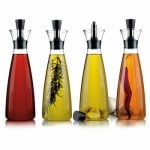Balsamic Vinegar
Consumers have a variety of high quality Balsamic Vinegars available to them for purchase and use.
- Balsamic Vinegar of Modena* – Traditional and Commercial (PGI)
- Traditional Balsamic Vinegar of Reggio Emilia
- Domestic Balsamic Vinegar Produced in the U.S. & North America
*Balsamic Vinegar not produced in Modena cannot use the term “of Modena” on its label. The protections afforded by the “Balsamic Vinegar of Modena” appellation refer to geographical restrictions of grape growing and processing and provide guidelines for ingredients and production techniques, based on historical practices.
Storage: Balsamic Vinegars have a very long shelf life and can be stored in a closed container indefinitely. It is suggested to store the product at 4 – 30°C (40-86°F), but refrigeration is not required. Exposure to air will not harm the product, but may cause “mothering,” which causes the solids to filter out. Some sedimentation is normal for a product that contains a high level of soluble solids (as with the aged products), but the sedimentation will disappear when the bottle is agitated.
Uses: Salad dressings, sauces and gravies benefit from the addition of Balsamic Vinegar. Sprinkle on cooked meats to add flavor and aroma; season salad greens, strawberries, peaches and melons; use as an ingredient in your favorite salad dressing.

 It is intriguing to think that in today’s computerized, sophisticated world, we’re still using one product that was discovered – quite by chance – more than 10,000 years ago.
It is intriguing to think that in today’s computerized, sophisticated world, we’re still using one product that was discovered – quite by chance – more than 10,000 years ago.